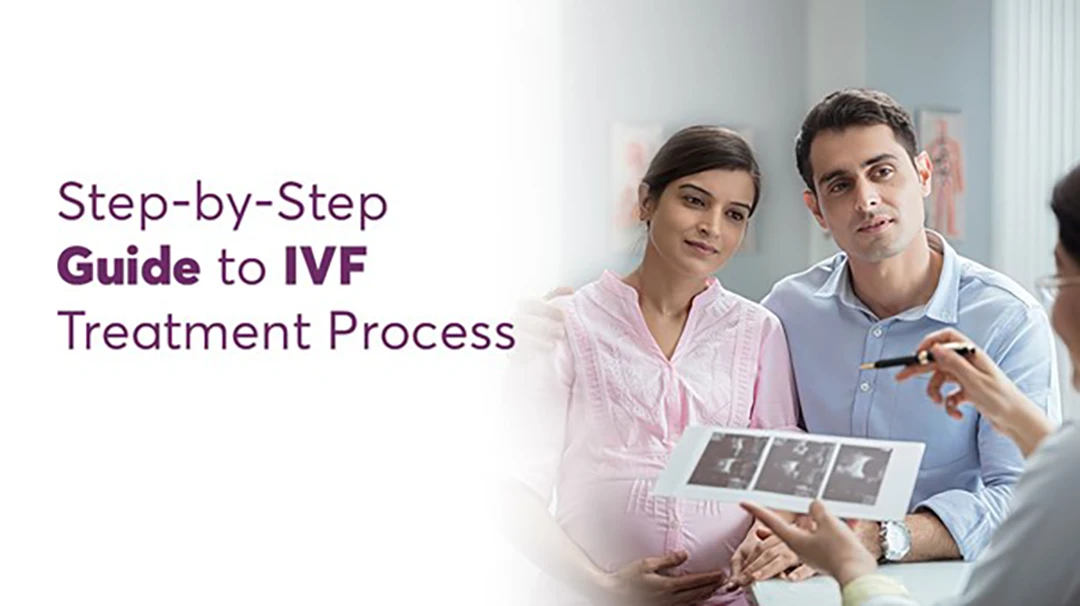
Whether you’re considering IVF for the first time or simply looking to learn about the process, understanding the steps involved can help reduce anxiety and prepare you for what lies ahead.
IVF Process
The IVF treatment process is a very complex and challenging journey, both emotionally and physically. It is natural to experience a mix of hope, anxiety, and stress during the process. Knowing what’s involved in the treatment can help you manage the side effects and feel more in control.
Here is a comprehensive step-by-step guide on the IVF treatment process:
1. Initial Consultation and Testing
When the IVF cycle begins, your doctor will conduct several pre-treatment tests. These tests usually include a baseline ultrasound, bloodwork for women and a semen analysis for the male partner to assess the fertility challenges and possibilities.
2. Birth control pills or Estrogen
Before you start your IVF treatment, your fertility specialist may provide you with birth control pills or Estrogen. These are used to stop the development of ovarian cysts and control the timings of your menstrual cycle. It allows your doctor to control your treatment and maximise the number of mature eggs during the egg retrieval procedure.
3. Ovarian Stimulation
Ovarian stimulation is a very critical part of egg production. By using prescribed medications, women can prepare for the egg retrieval process and increase their chances of successful pregnancy. Oral or injectable medications are often recommended for favourable result. Ovarian stimulation with the help of a transvaginal ultrasound to determine if the eggs have matured.
It also includes monitoring the response of medications by ultrasound and blood test; it can either take place daily or over a period of two weeks. Mostly, the stimulation period lasts between 8 to 14 days.
When the eggs are ready for the final maturation, a trigger shot is given to finalise the level of maturation of your eggs in preparation for egg retrieval.
4. Egg Retrieval
Egg retrieval process generally takes place approximately 36 hours after the last hormone trigger shot. When the egg retrieval process occurs , the patient receives a general anaesthesia to sleep during the procedure.
The eggs are retrieved by placing a thin needle through the vaginal wall into the ovary and suctioned from the follicles. After that, the retrieved eggs are placed in a dish containing a solution and put into an incubator. Finally, the test tubes are passed to the embryologist for fertilisation.
5. Fertilisation
Once the eggs are taken to the laboratory, they are visualised under a microscope and prepared for further fertilisation with either a fresh or frozen sperm. A procedure called Intracytoplasmic Sperm Injection (ISCI) is performed to inject healthy sperm into each of the viable eggs.
6. Embryo Freezing
The embryos will typically spend 5 – 7 days in the laboratory before they are ready to be frozen, or to be transferred back into the uterus.
7. Embryo Transfer
Preparing for embryo transfer is one of the most important processes in the IVF treatment process. On the day of the embryo transfer, the embryos are to be graded based on their cell growth and development. The grades and patient’s age helps the doctor, and couple decide on the appropriate number of embryos to transfer.
In the embryo transfer procedure, the cervix is visualised and cleaned. Ater that, a very thin catheter (tube) loaded with the embryo is placed gently through the cervix into the uterine cavity. The embryos are placed near the top of the uterus using ultrasound guidance.
8. Pregnancy Test
After two weeks of the embryo transfer, a blood test is done to determine the pregnancy. A sample is drawn from the patient and sent to the laboratory for analysis of human gonadotropin (HCG) levels. If the HCG level is detected above a certain level, it confirms pregnancy. If not, it means the embryo was not planted successfully.
It is important to understand that IVF treatment can vary from person to person, and it may take more than one cycle to achieve a successful pregnancy. Your fertility specialist will guide you through the long IVF process and provide detailed information and support at every step.
Conclusion
By following this step-by-step guide, you can navigate the IVF treatment process with more confidence. The long IVF journey can be overwhelming, but comprehending each step can make the whole process more manageable in an infertility clinic. From the initial consultation to the final pregnancy test, every phase plays a vital role in achieving your dream of parenthood.
Comments
comments